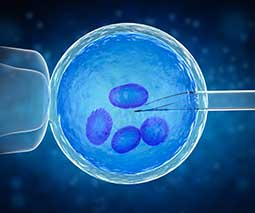Frankenbabies? Scientists say they’ve created genetically modified twin babies

In a scientific development that is making many extremely uncomfortable, a research team say they have edited the DNA in twin baby girls to protect them from disease. But have they? And should they?
Tinkering with new embryos
In the first reported case of babies (allegedly) born with modified DNA, a Chinese team used a technique called CRISPR.
This technique involves snipping into DNA strands to cut out unwanted sections (i.e. unwanted genetic conditions or genes that may promote disease) and replacing them with a different gene that is more desirable.
Humans are chock full of cells and DNA, but when a new human embryo is forming, it contains just one cell. This makes it the most efficient time to ‘edit’ DNA.
Read more about the science of parenting:
- Monkey bars are dangerous and must be removed from playgrounds, experts say
- How do sperm find their way to the egg?
- Does ‘spit cleaning’ your baby’s dummy help prevent future allergies?
Frankenbabies?
This CRISPR work is generally experimental and done with animal embryos, but a few carefully regulated labs have apparently been working with and editing human embryos too. Now it seems this team have been plugging away at this for quite some time.
“According to Chinese medical documents posted online this month (here and here), a team at the Southern University of Science and Technology, in Shenzhen, has been recruiting couples in an effort to create the first gene-edited babies,” Technology Review reports.
“They planned to eliminate a gene called CCR5 in hopes of rendering the offspring resistant to HIV, smallpox, and cholera.”
Documentation around the team’s work shows that they have used CRISPR not just on brand new human embryos, but on 24-week gestation foetuses, Technology Review says.
One baby is a “patchwork of cells with various changes”
“Researcher He Jiankui of Shenzhen said he altered embryos for seven couples during fertility treatments, with one pregnancy resulting thus far,” AP says.
Full details are patchy and there has been no independent confirmation of his claims, nor has it been published in any scientific journals. The purported goal of this work has also been called into question.
“He said his goal was not to cure or prevent an inherited disease, but to try to bestow a trait that few people naturally have — an ability to resist possible future infection with HIV, the AIDS virus.”
An AP report on this work says that in the case of these twins, the editing seems incomplete. One twin has had both genes that affect HIV susceptibility edited, but the other has only had ONE of the required TWO modified.
One of the twins also exhibits “a patchwork of cells with various changes”. #DearGod
Prevention or practise?
“It’s almost like not editing at all” if only some of certain cells were altered, because HIV infection can still occur, Harvard University geneticist George Church told AP.
Scientists are not at all keen on this kind of gene tampering. While some think tackling the very real health threat of diseases such as HIV is important, they see altering human embryos and foetuses as unethical and premature partly because we simply don’t know enough about how this may play out in the long term.
Church says the fact that the research team used an embryo that had not been completely modified to prevent HIV may suggest their “main emphasis was on testing editing rather than avoiding this disease.”
Scary stuff.








